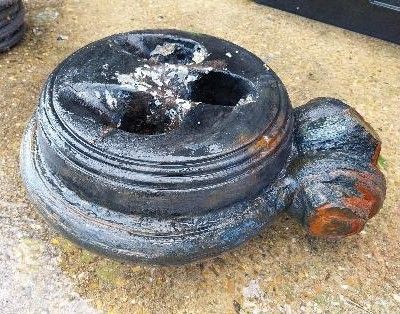
SS ONTARIO
DEAD EYES
Written by Nick Schiller / Images Nick Schiller / Reported to the ROW June 2025 (Nick Schiller)
A Dead Eye is a disc shaped piece of wood, usually lignum vitae or elm, with three holes through it. They are used in pairs, one above the other, to create a 6:1 purchase system, effectively static pulley blocks. The upper would be attached to the stay and the stay, in turn attaches to the mast to support it. The lower would be attached to gunwales or in case through the gunwale down the side of the ship to a chain plate most likely bolted into a main rib, the rib would then be cross braised internally to resist the crushing load across the beam of the ship. The two dead eyes are laced together with a lanyard. The loose tail of the lanyard is then attached to a block and tackle, typically 3:1 or more, giving in excess of 18:1 in the form of a cascade purchase system. Usually 8:1 is the maximum before friction overwhelms the benefit of adding more purchase but by using a cascade far higher purchase rations can be achieved, eg 6:1 on the dead eyes and then 4:1 tackle would yield 24:1 but there would be significant frictional loses. Often the lanyard was lubricated with something like lanoline (sheep fat) on the dead eyes to reduce the friction. This allowed suitable tension to be applied to the stays and thereby support the mast under sailing loads. Once the tension was applied, a small wedge of wood was driven between the dead eye and the lanyard to lock the tension in before removing the additional tackle from the tail of the lanyard. The loose end of the lanyard is then secured with half hitches to the stay just above the upper dead eye, this is to prevent the rig slipping if the wooden wedge were to become dislodged and to stow the tail of lanyard safely for when the tension needs to be adjusted or dropped to allow the mast to be removed. Often the loose tail was also siezed to itself with a piece of tarred marlin as a further security against release. Siezing is like serving, ie winding the marlin around the two ropes, but then it is drawn down in between the rope to tension the serving tighter and tied off. The finished product looks like this which is taken from Excelsior, a 100 year old Lowestoft sailing trailer. Although note that the lanyard on this set up is not moused. You can clearly see the tail of the lanyard secured above the upper dead eye and seizing of the lanyard to itself to prevent any slippage or loss of tension.
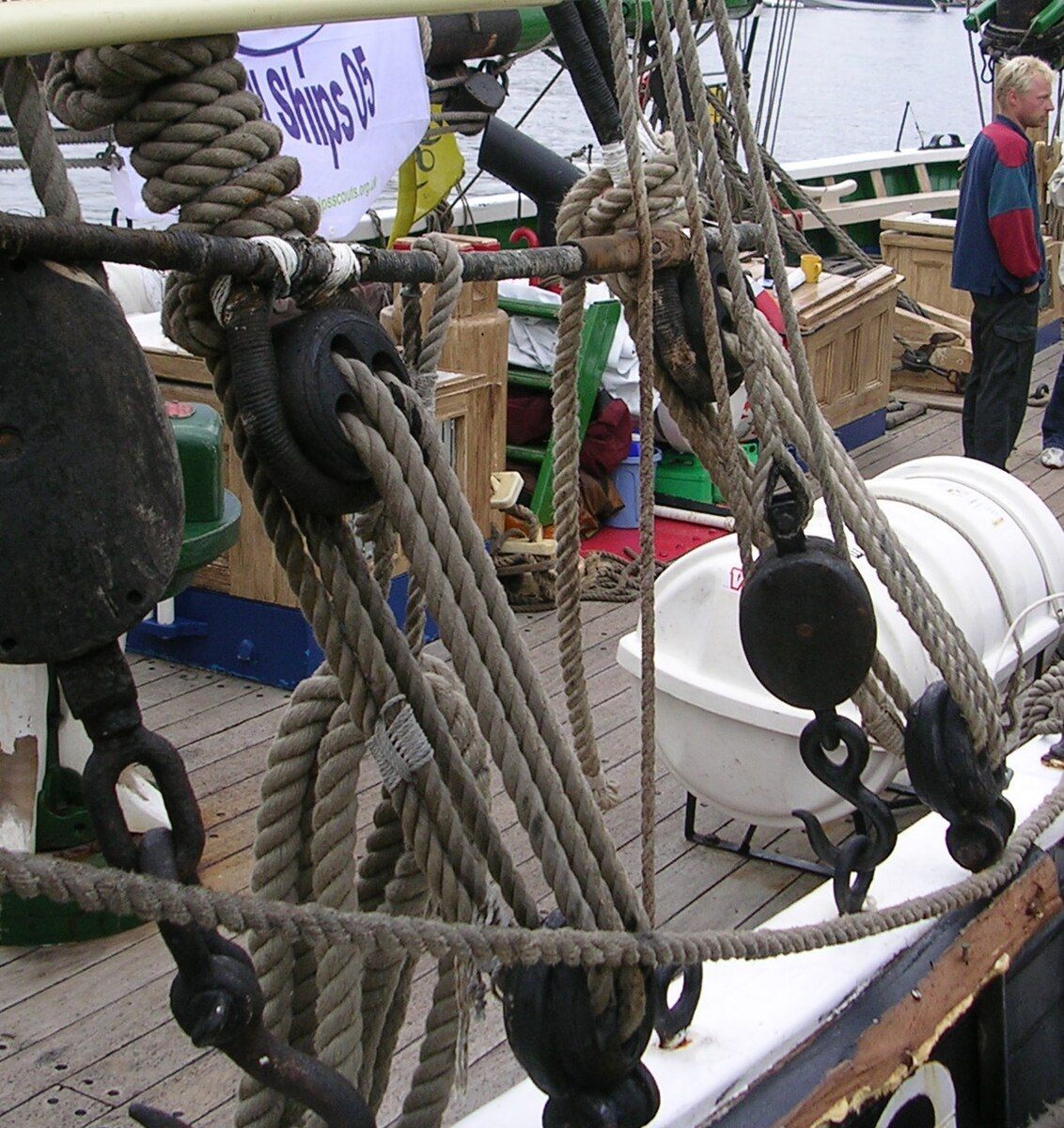
The picture below shows the dead eyes just above the gunwales on Excelsior, in this case 3 pairs each side, and the stays or shrouds running up to support the mast head. In this case the stays are not secured to the upper dead eye with a Liverpool eye splice, they are simply seized where you can see the white bands above the upper dead eye. They are however moused, parcelled, served with tarred marlin and finished with slush as described later in this article. The horizontal bars and ropes between the stays are called ratlines, they are there to allow the crew to relatively safely climb the rigging at sea, either for maintenance work, sail triming or to gain a better look out.
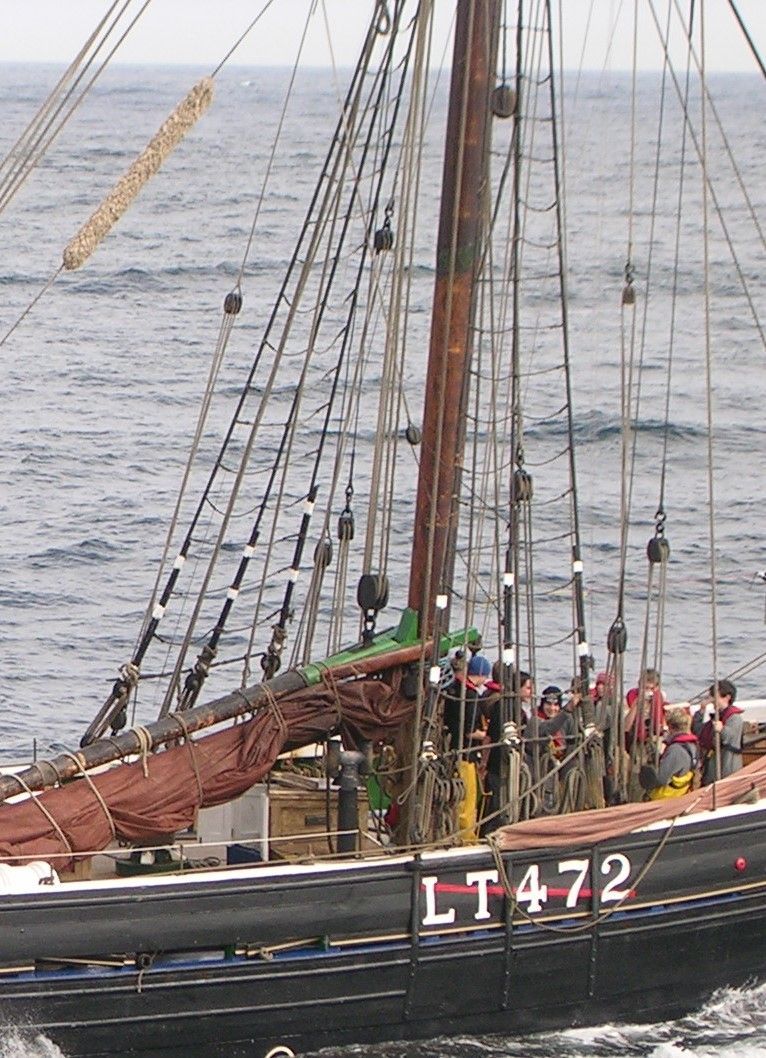
The dead eye below is from SS Ontario and is an upper and is almost certainly elm. This first picture is immediately after recovery with a small amount of cleaning complete and the second after all the build-up has been removed. At the top in the first picture, you can see the remains of the lanyard secured around the stay leading to the mast.
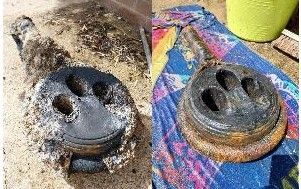
The lanyard in this case was 3 core hemp about 1” diameter which had been moused with a smaller perhaps ¼” three strand hemp rope. Mousing, is where a line is laid into the groves between the strands of a rope to smooth it out. Below you can see a section of that rope with the mousing clearly visible. The fibres within the rope are in extraordinarily good condition, still strong and the same colour as fresh hemp!
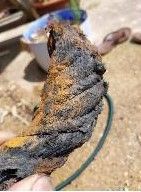
The upper dead eye is secured using a Liverpool eye splice. This is a method of splicing steel wire. It is fundamentally different to the way you splice rope but achieves the same outcome of a secure permanent fixed eye. This wire is interesting, comprising two different sets of wire. A series of bundles of thin wire and also some much thicker strands as pictured below. From the right, you can see the hemp mousing, then a thick single strand wire and then a bundle of thinner steel wires.
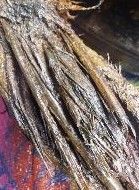
Before the splice is formed the section of wire that will sit against the dead eye is prepared. First, like the lanyard, the wire is moused with hemp. Then it is parcelled with hemp fabric which involved raping the whole section in hemp fabric, see picture below. Finally it is served with tarred marlin, which is the string like material you can see wrapped around the edge of the dead eye. Tarred marlin is hemp string, coated in a mixture of Stokholm tar and solvents. Stokholm tar is distilled from pine sap and has a distinctive smell which is still present on these ropes. The tar in this form will not set and remains flexible to allow it to be worked.
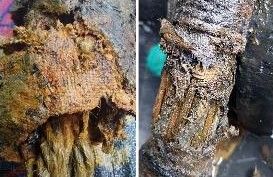
Once the splice is formed, it is beaten with a lead or wooden mallet to smooth it out. This then parcelled in hemp fabric and served with tarred marlin. The serving will run the entire length of the stay and is applied use a device called a servicing mallet which allow this work to be done very quickly and with a constant tension on the marlin.
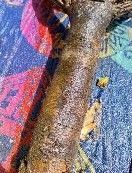
Finally, to protect the whole assembly all the serving is coat with slush, a combination of Stockholm tar, linseed oil and solvents. The linseed oil is added to make the mixture set. This will set in the sun and form a hard shiny black coating which many will be familiar with from visiting old ships, eg HMS Victory or the Cutty Sark. This needs to be reapplied annually to protect the serving and the more importantly the steel stay within.
Below is an image of a lower dead eye from the same wreck, in actual fact the pair to the upper above. This was secured to the gunwale with a 1½” wrought iron eye bolt secured to the wrought iron collar around the dead eye. You can see the fibrous structure of the wrought iron due to preferential corrosion of the carbon rich areas of the material. These are formed by heating high carbon iron and beating them to form bar and then forming this around the dead eye. High carbon steel can be quite brittle but the forging process breaks up the carbon and prevents it acting as a facture initiation site and hence makes it tough enough for this type of application
In this case the securing bars for the lower dead eyes ran through the gunwales, down the side of the ship and would have been secured to chain plates. The gunwales simply wouldn’t have been strong enough to support such large masts.

These dead eyes will be soaked in fresh water for several months to remove the salt, then in PEG to replace most of the water before being dried slowly in a humid environment. Hopefully, this is prevent cracking and promote preservation. I will also apply slush to the servings to help preserve them once dry. Finally, they will be laced with a moused hemp lanyard and displayed somewhere in my house…..

